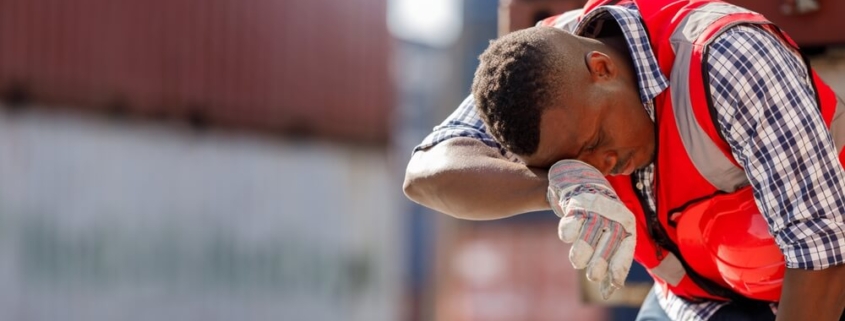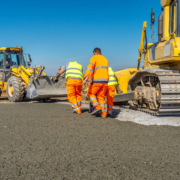Summer Workplace Hazards in Construction
We are already well into summer, and some areas of the country have experienced record-breaking temperatures. In fact, the planet saw its hottest day on record in early July, with daily highs in Tucson reading 110 degrees and Tampa at 97 degrees. These are extreme temperatures, which can make outdoor activities like construction work even more hazardous.
Every year, construction workers become ill at their workplaces, and some even lose their lives due to extreme heat exposure. While an employer may have a job to do, worker safety is also a critical consideration. Here are some of the top summer workplace hazards in construction and how to address them.
1. Extreme Fatigue
Because many construction jobs require workers to perform manual labor, this can lead to extreme fatigue in the summer months. One of the biggest concerns with fatigue is that it can impair judgment and lead to other serious injuries.
Similar to drowsy driving, a fatigued worker will have slow reaction times, poor judgment, and impaired physical functioning. This can put the worker and others at risk.
To prevent these problems, workers are encouraged to drink plenty of fluids throughout the day and eat salty snacks to replenish lost sodium. They should avoid direct sunlight as much as possible and wear sun protection.
2. Dehydration
Dehydration happens when your body loses more water than it is taking in, resulting in you not having any reserves necessary for normal bodily functions. As you can imagine, this is dangerous. If not treated properly, dehydration can lead to death.
Construction workers can get busy on the job and forget to drink enough water. When it’s hot out, sweat also contributes to dehydration. Some of the symptoms of dehydration include:
- Lightheadedness
- Confusion
- Fainting
- Rapid breathing
- Rapid heart rate
- Little or no urination
To prevent dehydration, it’s important to take frequent hydration breaks at work. Some workers can have a hard time drinking water because it’s tasteless. Electrolyte beverages like Gatorade or Powerade can encourage regular consumption of fluids. But soda and coffee are not sufficient substitutes.
Employers should also educate workers on proper hydration outside of work to continue boosting electrolytes. And if there are any signs of dehydration, immediate assistance is necessary.
3. Heat Stroke
The Occupational Safety and Health Administration (OSHA) reports that up to 70% of workplace fatalities occur while working in hot or warm environments. OSHA warms that heat-related illnesses are “medical emergencies.”
When a worker experiences heat stroke, their body is unable to cool down on its own. The body can reach temperatures as high as 106 degrees, which can be fatal.
One common sign of heat stroke is cramps, where the loss of water causes the muscles to painfully contract. If a worker is suffering from heat cramps, they should stop work immediately, rest in a shaded and cool place, and not resume activities until they feel better. Other common signs of heat stroke include:
- Nausea
- Headache
- Heavy sweating
- Weakness
- High body temperature
OSHA recommends only allowing new construction workers to perform their duties at full intensity for about 20% of the workday in the heat. If there is doubt about whether someone needs medical care, the best option is to call 911.
4. Sun Exposure
Too much exposure to the sun poses significant risks for construction workers. Hard hats do double duty by protecting a worker’s head from falling objects and offering sun protection. But what about the rest of your body?
The sun’s UV rays can harm your arms, legs, face, and eyes and impact the immune system. Any skin that is exposed to sunlight can be burned and even get blisters. This can also happen on cloudy days.
If possible, workers should be encouraged to wear long-sleeve shirts and pants while working. They should also wear eye protection and use sunscreen with a minimum SPF of 15.
5. Road Work Zones
According to NIOSH, nearly 20,000 workers are injured and 100 killed in work zones each year. In colder climates, road work accelerates in the summer months because it isn’t possible to do so during other parts of the year. For workers, however, this can be a dangerous situation.
Bright safety vests are critical. They provide visibility that can prevent collisions with heavy equipment. Workers must also be trained to identify work areas and use barriers to keep traffic out of work zones. Workers should also be educated bout additional traffic-related hazards.
What If You’ve Been Injured on a Construction Site?
If you’ve suffered a workplace injury on a construction site this summer, it’s important to understand that your employer has an obligation to provide a safe workplace that protects you from harm. Appropriate training and safeguards are vital parts of workplace preparedness. To learn more about protecting and asserting your rights, contact OSHA Injury Attorney directly.




 Extreme weather events are not only costly for homeowners and businesses, they also present an ongoing challenge for cleanup crews.
Extreme weather events are not only costly for homeowners and businesses, they also present an ongoing challenge for cleanup crews.
Leave a Reply
Want to join the discussion?Feel free to contribute!